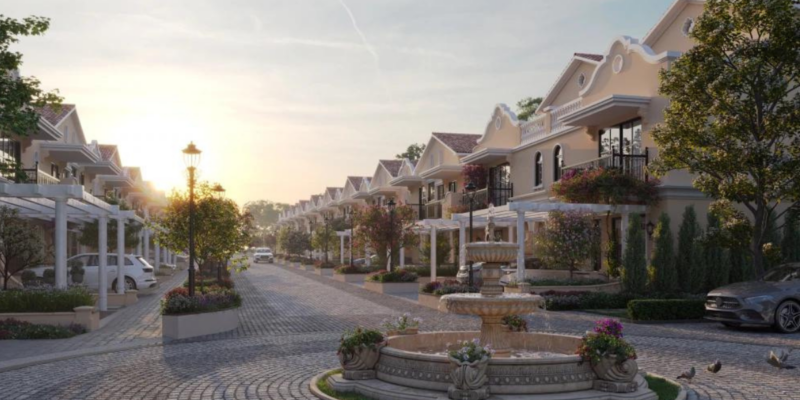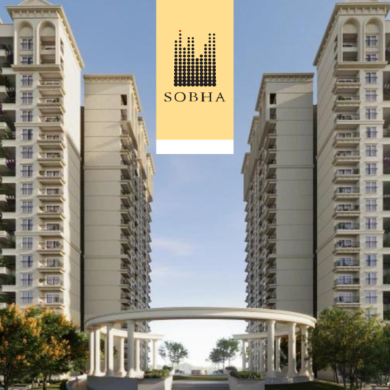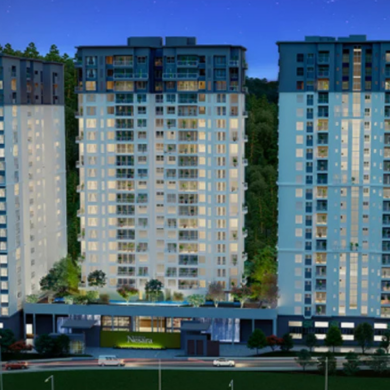
Villas and row houses offer distinct living experiences. Villas provide standalone luxury with private spaces, while row houses are a series of connected homes with common walls and a blend of privacy & community living.
Diverse housing options in India cater to varied preferences. In urban areas, land is at a premium, and apartments are preferred as they save land through verticalisation. Apartments are also preferred as they offer compact living with shared amenities. Duplex flats feature two levels within an apartment, providing a vertical living experience and more space.
Villas are standalone homes, with ample space, private gardens, & higher privacy. Row houses are individual homes in a series with shared walls, and they balance privacy with community living. Each of these housing options offers unique lifestyle choices to suit different needs & preferences of individuals and families.
Villas and row houses are gaining popularity in Indian metros due to their blend of space, privacy, and community feel. With increasing urbanisation, these options offer standalone homes or individual units, providing a break from high-rise living. They cater to elite needs such as personal space, private gardens, and modern amenities – while maintaining a sense of community living. This trend reflects a shift towards larger yet connected living spaces in bustling urban environments.
Let’s go through the differences between villas and row houses, which is important as you need to take an informed decision based on your lifestyle needs – such as space, privacy, community interaction, and overall aspirations.
Table of Contents
8 Key Differences Between Villas and Row Houses
-
Definition and Characteristics of Villas and Row Houses
Villas and row houses embody distinct residential styles. Villas are spacious homes on individual plots, giving you sole ownership of both the house & land. They provide extensive personal space, include private gardens & verandas, and enhance privacy & exclusivity.
Row houses are attached structures in a series, sharing common walls between adjacent homes. Each residence maintains a degree of individuality while fostering a sense of community living. Row houses offer more compact living spaces than villas, utilising vertical or horizontal layouts to accommodate multiple homes within a smaller land area.
Land ownership is a key differentiator – villa owners possess the land their property stands on, while row house owners usually hold joint ownership of common areas. You can choose between spacious, standalone, costlier villa living on one hand, and the balance between privacy & community offered by row houses on the other.
-
Architectural Design of Villas and Row Houses
Villas and Row houses boast distinctive architectural designs. Villas offer customisable layouts – allowing you to tailor spaces according to your family’s preferences. These standalone homes showcase diverse architectural styles & unique appearances, and often feature personalised outdoor areas like gardens, courtyards, or private pools.
Conversely, row houses typically follow standardised layouts across attached units, emphasising uniformity in appearance & design. The architecture is usually consistent throughout the row, limiting individual customisation. However, the advantage of row houses is a stronger sense of community, which can help you bond with like-minded families. Shared outdoor spaces like community gardens or common areas foster a collaborative atmosphere among residents.
Regarding villas vs row houses, the architectural distinction lies in the level of personalisation. Villas provide scope for unique, tailored designs and spacious personal outdoor areas. Row houses offer a uniform appearance and shared outdoor spaces, focusing on balancing individuality and communal living.
-
Ownership and Land of Villas and Row Houses
This is a key villa and row house difference. Villas typically grant individual land ownership, providing homeowners autonomy over their plots. This ownership extends to the house and surrounding land – allowing extensive landscaping, exterior modifications, and personalisation. You can freely design your garden or veranda, install amenities, or alter exteriors – with a high level of autonomy.
On the other hand, row houses commonly entail shared land ownership of common areas, where residents hold joint responsibility. While you have complete ownership of your home, the shared land restricts full autonomy in exterior modifications or landscaping choices. Due to collective ownership, you may have limited scope for personalising the surrounding spaces or altering the exteriors – prioritising uniformity within the community.
In the case of land ownership for villa vs row house – villas offer individual ownership and high autonomy, allowing extensive landscaping and modifications. With shared land, row houses limit individual alterations owing to communal uniformity and shared responsibilities.
-
Privacy and Independence of Villas and Row Houses
Being standalone properties on individual plots, villas offer enhanced privacy with ample distance from neighbouring homes – providing you with a quieter living environment. Villas also allow greater independence, facilitate personalised landscaping & exterior modifications, and minimise noise interference due to fewer shared walls.
Row houses consist of connected homes, sharing common walls between neighbouring homes – which can lead to more noise interference due to proximity. However, the advantage of this is a sense of community, and bonding between like-minded families and individuals. Despite limitations on complete independence due to the interconnecting walls, rowhouses foster a strong sense of camaraderie and unity.
-
Maintenance and Responsibilities
The maintenance and responsibilities of villas & row houses differ due to their distinct structural designs. With individual ownership of both home and land, villas entail sole responsibility for all maintenance – including exteriors, landscaping, utilities, and infrastructure. You will have full autonomy in overseeing & financing maintenance – ensuring personalised care but bearing the entire cost.
Although homeowners own individual homes in the case of row houses, maintenance is often shared for common areas like driveways, pathways, or communal facilities. Along with your neighbours, you can jointly contribute to shared space maintenance, governing body fees, or community upkeep. These shared responsibilities foster a sense of collective ownership and divide costs among multiple families. However, decisions on maintenance would typically involve collaborative agreements or community consensus.
-
Cost Considerations
This is an important villa and row house difference. Villas often entail higher upfront costs due to individual land ownership, larger land area, and personalised amenities – resulting in higher initial investment. However, their potential for substantial appreciation lies in the exclusivity, expansive space, and customisations – attracting premium pricing in the real estate market over time.
Conversely, row houses generally offer more affordable upfront costs, thanks to shared land & infrastructure, common walls, and smaller land footprints. This results in reduced investment requirements. Maintenance costs are lower, too, as responsibilities for common areas are shared among residents – leading to collective cost-sharing and potentially lower upkeep expenses.
-
Community Living
Villas provide you with increased isolation from neighbours, leading to a private, tranquil living environment conducive to solitude. Distance between properties and personalised outdoor spaces like gardens or yards offer a serene retreat, ideal for those seeking privacy and seclusion, creating a haven away from neighbouring activities.
Conversely, row houses offer you closer proximity to neighbours, cultivating a stronger sense of community living. This encourages interactions, shared experiences, and collaborative engagement among residents – fostering a sense of camaraderie and collective living. Shared walls & common areas facilitate regular social interactions, promoting a vibrant community atmosphere. All this makes row houses more appealing to individuals & families seeking a more interconnected and socially engaging living environment.
-
Resale Value
Historically known for their stable and appreciating values, villas appeal to discerning buyers seeking exclusivity, privacy, and long-term investment potential. Their standalone nature, larger land areas, and customised amenities often command premium prices – attracting buyers interested in upscale living and potential appreciation over time. The exclusivity and luxury of villas typically appeal to affluent buyers or those desiring luxurious, spacious living spaces.
Row houses may showcase varied resale values, that in turn depend on location and demand dynamics. Their affordability and flexibility in terms of space cater to a broader spectrum of luxury homebuyers. Diversity in pricing and a wide range of unit sizes & designs make row houses appealing to a more extensive buyer demographic seeking comfortable housing options in varying locations.
Villas vs Row Houses
Parameter |
Villas |
Row Houses |
|
Type |
Individual structure |
Joint structures |
|
Size |
Larger |
Relatively smaller |
|
Ownership |
Both land & building |
Common walls; land ownership might be common |
|
Design |
Customised |
Standard |
|
Architecture |
Unique |
Uniform |
|
Outdoors |
Private garden, veranda, etc |
Common amenities / outdoor spaces |
|
Ownership |
Both house & land |
Shared, in some cases |
|
Autonomy |
Complete freedom in landscaping, etc |
Limited autonomy in any modifications to be done outdoors |
|
Privacy |
High, as these are standalone homes |
Slightly lesser, due to common walls |
|
Noise |
Less interference from neighbours |
Higher possibility of sound-related disturbances |
|
Maintenance |
Full responsibility |
Responsibility shared with neighbours |
|
Landscaping |
Personal basis |
Association of homeowners |
|
Cost |
Higher upfront cost of ownership |
Relatively more affordable |
|
Long-term |
Generally greater price appreciation |
Typically lower maintenance cost |
|
Proximity |
More isolated |
Closer proximity to neighbours |
|
Privacy |
More solitude & serenity |
Strong community sense |
|
Value |
Continual appreciation in value |
Different resale values, depending on demand & location |
|
Buyers |
Appeals to limited buyer demographics | Appeals to a broader range of homebuyers |
Conclusion
Villas and row houses present distinct residential choices. Villas stand independently, providing you sole ownership of the house & land, facilitating extensive personalisation, and offering spacious layouts with private gardens. On the other hand, row houses have common walls between homes, and they strike a balance between privacy & community living. These residences offer more compact spaces with shared land ownership, restricting individual modifications.
In terms of architectural differences, villas allow customised designs, high level of personalisation, and spacious outdoor areas. Row houses often have standard layouts and shared outdoor spaces that promote communal interactions.
Since villas have individual land ownership, they provide autonomy in landscaping and exterior modifications, while row houses involve shared responsibilities, favouring uniformity. The privacy factor distinguishes them further – villas ensure seclusion, while row houses foster a sense of community due to closer proximity among neighbours.
Despite higher upfront costs, villas attract affluent buyers seeking exclusivity and potential appreciation. In contrast, row houses have varied resale values, cater to a broader demographic, and foster a stronger sense of community living.
FAQ’s
1. What is the difference between a villa and row house?
Difference between a villa and row house is that villa is a standalone homes with private gardens & enhanced privacy, while row houses are connected homes with common walls and a blend of privacy & community living.
2. What is meant by row house?
Row houses are individual homes constructed in a series. Featuring shared walls, they balance privacy with community living.
3. What is another name for row house?
Another name for row house is terraced house or townhouse
4. Why are houses called villas?
Houses are called villas because originally the word ‘villa’ meant a country house of an affluent family located outside the city centre. In modern times, ‘villa’ meant larger, standalone homes equipped with private amenities like gardens, pools, verandas, etc
5. Which house is called villa?
An individual house with complete land ownership, large area, and extensive outdoor spaces & amenities is called a villa.
6. What are 3 houses in a row called?
3 or more houses in a row are called row houses, which provide an excellent blend of privacy and community living.
7. What is a row house style?
A row house style is a type of housing where many individual homes that look similar are built side-by-side in a row. These residences share common walls, and create a consistent appearance along a street.
8. What is a single row villa?
A single row villa is a standalone house built in a linear manner, with houses aligned one after the other in a row, often along a street. Single row villas might share common elements such as a boundary wall, but they are separate individual units not attached to each other.







